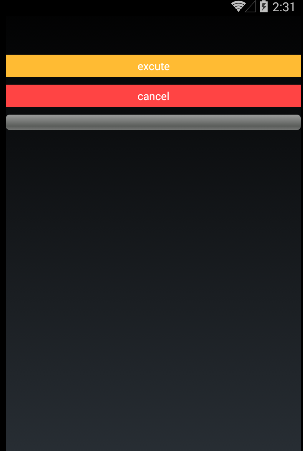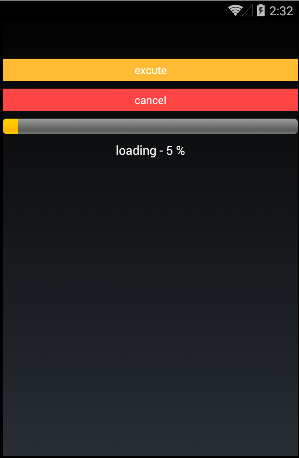Android:AsyncTask详解(2)
在Android中实现异步任务机制有两种方式,Handler和AsyncTask。
Handler模式需要为每一个任务创建一个新的线程,任务完成后通过Handler实例向UI线程发送消息,完成界面的更新,这种方式对于整个过程的控制比较精细,但也是有缺点的,例如代码相对臃肿,在多个任务同时执行时,不易对线程进行精确的控制。Android1.5提供了工具类android.os.AsyncTask,它使创建异步任务变得更加简单,不再需要编写任务线程和Handler实例即可完成相同的任务。
AsyncTask的定义:
public abstract class AsyncTask<Params, Progress, Result> {
三种泛型类型分别代表“启动任务执行的输入参数”、“后台任务执行的进度”、“后台计算结果的类型”。在特定场合下,并不是所有类型都被使用,如果没有被使用,可以用java.lang.Void类型代替。
一个异步任务的执行一般包括以下几个步骤:
1.execute(Params... params),执行一个异步任务,需要我们在代码中调用此方法,触发异步任务的执行。
2.onPreExecute(),在execute(Params... params)被调用后立即执行,一般用来在执行后台任务前对UI做一些标记。
3.doInBackground(Params... params),在onPreExecute()完成后立即执行,用于执行较为费时的操作,此方法将接收输入参数和返回计算结果。在执行过程中可以调用publishProgress(Progress... values)来更新进度信息。
4.onProgressUpdate(Progress... value),在调用publishProgress(Progress... values)时,此方法被执行,直接将进度信息更新到UI组件上。
5.onPostExecute(Result result),当后台操作结束时,此方法将会被调用,计算结果将做为参数传递到此方法中,直接将结果显示到UI组件上。
格外注意:
1.异步任务的实例必须在UI线程中创建。
2.execute(Params... params)方法必须在UI线程中调用。
3.不要手动调用onPreExecute(),doInBackground(Params... params),onProgressUpdate(Progress... values),onPostExecute(Result result)这几个方法。
4.不能在doInBackground(Params... params)中更改UI组件的信息。
5.一个任务实例只能执行一次,如果执行第二次将会抛出异常。
下面结合实例分析如何使用AsyncTask执行异步任务操作。
创建一个项目

看看AsyncTaskActivity.java的代码
package com.alexwan.asynctaskdemo;
import java.io.ByteArrayOutputStream;
import java.io.InputStream;
import org.apache.http.HttpEntity;
import org.apache.http.HttpResponse;
import org.apache.http.HttpStatus;
import org.apache.http.client.HttpClient;
import org.apache.http.client.methods.HttpPost;
import org.apache.http.impl.client.DefaultHttpClient;
import android.app.Activity;
import android.os.AsyncTask;
import android.os.Bundle;
import android.util.Log;
import android.view.View;
import android.view.View.OnClickListener;
import android.widget.Button;
import android.widget.ProgressBar;
import android.widget.TextView;
public class AsyncTaskActivity extends Activity implements OnClickListener
{
//取消,确认按钮
private Button mExecuteBtn, mCancelBtn;
//文本
private TextView mTextView;
//进度条
private ProgressBar mProgressBar;
@Override
protected void onCreate(Bundle savedInstanceState)
{
super.onCreate(savedInstanceState);
setContentView(R.layout.activity_async_task);
mExecuteBtn = (Button) findViewById(R.id.excute_btn);
mExecuteBtn.setOnClickListener(this);
mCancelBtn = (Button) findViewById(R.id.cancel_btn);
mCancelBtn.setOnClickListener(this);
mProgressBar = (ProgressBar) findViewById(R.id.progress_bar);
mTextView = (TextView) findViewById(R.id.text_view);
}
private GetAsyncTask task;
@Override
public void onClick(View v)
{
switch (v.getId())
{
case R.id.excute_btn:
task = new GetAsyncTask();
task.execute("http://www.baidu.com");
mExecuteBtn.setClickable(false);
mCancelBtn.setClickable(true);
break;
case R.id.cancel_btn:
if (task != null)
{
task.cancel(true);
}
break;
default:
break;
}
}
private class GetAsyncTask extends AsyncTask<String, Integer, String>
{
@Override
protected void onPreExecute()
{
//task执行前的UI
mTextView.setText("loading...");
}
@Override
protected String doInBackground(String... params)
{
//后台处理耗时任务,这里不能修改UI
try
{
//使用HttpClinet建立Http连接
HttpClient client = new DefaultHttpClient();
//使用Post请求
HttpPost post = new HttpPost(params[0]);
HttpResponse response = client.execute(post);
//获取StatusCode == 200 就说明正常返回报文
if (response.getStatusLine().getStatusCode() == HttpStatus.SC_OK)
{
HttpEntity entity = response.getEntity();
InputStream is = entity.getContent();
long total = entity.getContentLength();
ByteArrayOutputStream baos = new ByteArrayOutputStream();
byte[] buf = new byte[1024];
int count = 0;
int length = -1;
while ((length = is.read(buf)) != -1)
{
baos.write(buf, 0, length);
count += length;
//调用publishProgress公布进度,最后onProgressUpdate方法将被执行
publishProgress((int) ((count / (float) total) * 100));
}
return new String(baos.toByteArray(), "utf-8");
}
}
catch (Exception e)
{
Log.e("alexwan---------exception", e.getMessage());
}
return null;
}
@Override
protected void onPostExecute(String result)
{
//task执行的结果
mTextView.setText(result);
mExecuteBtn.setClickable(true);
mCancelBtn.setClickable(false);
}
@Override
protected void onProgressUpdate(Integer... values)
{
//在调用publishProgress()方法之后,执行
//更新进度条
mTextView.setText("loading - " + values[0] + " %");
mProgressBar.setProgress(values[0]);
}
@Override
protected void onCancelled()
{
//取消任务后,自动调用
mProgressBar.setProgress(0);
mTextView.setText("");
mExecuteBtn.setClickable(true);
mCancelBtn.setClickable(false);
}
}
}布局文件activity_async_task.xml的代码
<LinearLayout xmlns:android="http://schemas.android.com/apk/res/android"
xmlns:tools="http://schemas.android.com/tools"
android:layout_width="match_parent"
android:layout_height="match_parent"
android:orientation="vertical"
tools:context="com.alexwan.asynctaskdemo.AsyncTaskActivity" >
<Button
android:id="@+id/excute_btn"
android:layout_width="match_parent"
android:layout_height="wrap_content"
android:layout_marginTop="50dp"
android:background="@android:color/holo_orange_light"
android:gravity="center"
android:padding="5dp"
android:text="excute"
android:textColor="@android:color/white" />
<Button
android:id="@+id/cancel_btn"
android:layout_width="match_parent"
android:layout_height="wrap_content"
android:layout_marginTop="10dp"
android:background="@android:color/holo_red_light"
android:clickable="false"
android:gravity="center"
android:padding="5dp"
android:text="cancel"
android:textColor="@android:color/white" />
<ProgressBar
android:id="@+id/progress_bar"
style="?android:attr/progressBarStyleHorizontal"
android:layout_width="match_parent"
android:layout_height="wrap_content"
android:layout_marginTop="10dp"
android:max="100"
android:progress="0" />
<ScrollView
android:layout_width="match_parent"
android:layout_height="0dp"
android:layout_weight="1" >
<TextView
android:id="@+id/text_view"
android:layout_width="match_parent"
android:layout_height="wrap_content"
android:layout_margin="10dp"
android:gravity="center"
android:textColor="@android:color/white"
android:textSize="16sp" />
</ScrollView>
</LinearLayout>因为需要访问网络,所有我们还需要在AndroidManifest.xml中加入访问网络的权限
<uses-permission android:name="android.permission.INTERNET" />
运行的界面效果图:




AsyncTask是对Thread和Handler的良好封装,下面介绍AsyncTask的执行原理
AsyncTask大纲原理图:

我们可以看到关键几个步骤的方法都在其中,doInBackground(Params... params)是一个抽象方法,我们继承AsyncTask时必须覆写此方法;onPreExecute()、onProgressUpdate(Progress... values)、onPostExecute(Result result)、onCancelled()这几个方法体都是空的,我们需要的时候可以选择性的覆写它们;publishProgress(Progress... values)是final修饰的,不能覆写,只能去调用,我们一般会在doInBackground(Params... params)中调用此方法;另外,我们可以看到有一个Status的枚举类和getStatus()方法,Status枚举类代码段如下
/**
* Indicates the current status of the task. Each status will be set only once
* during the lifetime of a task.
*/
public enum Status {
/**
* Indicates that the task has not been executed yet.
*/
PENDING,
/**
* Indicates that the task is running.
*/
RUNNING,
/**
* Indicates that {@link AsyncTask#onPostExecute} has finished.
*/
FINISHED,
}
/**
* Returns the current status of this task.
*
* @return The current status.
*/
public final Status getStatus() {
return mStatus;
}可以看到,AsyncTask的初始状态为PENDING,代表待定状态,RUNNING代表执行状态,FINISHED代表结束状态,这几种状态在AsyncTask一次生命周期内的很多地方被使用,非常重要。
AsyncTask执行流程
介绍完大纲视图相关内容之后,接下来,我们会从execute(Params... params)作为入口,重点分析一下AsyncTask的执行流程,我们来看一下execute(Params... params)方法的代码段:
public final AsyncTask<Params, Progress, Result> execute(Params... params) {
return executeOnExecutor(sDefaultExecutor, params);
}
public final AsyncTask<Params, Progress, Result> executeOnExecutor(Executor exec, Params... params) {
if (mStatus != Status.PENDING) {
switch (mStatus) {
case RUNNING:
//如果该任务正在执行,则抛出异常
throw new IllegalStateException("Cannot execute task:" + " the task is already running.");
case FINISHED:
//如果该任务已经结束,则抛出异常
throw new IllegalStateException("Cannot execute task:" + " the task has already been executed "+ "(a task can be executed only once)");
}
}
//将状态改为RUNING
mStatus = Status.RUNNING;
onPreExecute();
mWorker.mParams = params;
exec.execute(mFuture);
return this;
}代码中涉及到三个陌生的变量:mWorker、sDefaultExecutor、mFuture,我们也会看一下他们的庐山真面目:
关于sDefaultExecutor,它是java.util.concurrent.ThreadPoolExecutor的实例,用于管理线程的执行。代码如下:
//final 线程池执行器,用于管理线程的执行
public static final Executor THREAD_POOL_EXECUTOR = new ThreadPoolExecutor(CORE_POOL_SIZE, MAXIMUM_POOL_SIZE, KEEP_ALIVE, TimeUnit.SECONDS, sPoolWorkQueue, sThreadFactory);
//AsyncTask的内部类
public static final Executor SERIAL_EXECUTOR = new SerialExecutor();
private static volatile Executor sDefaultExecutor = SERIAL_EXECUTOR;
private static class SerialExecutor implements Executor {
final ArrayDeque<Runnable> mTasks = new ArrayDeque<Runnable>();
Runnable mActive;
public synchronized void execute(final Runnable r) {
mTasks.offer(new Runnable() {
public void run() {
try {
r.run();
} finally {
scheduleNext();
}
}
});
if (mActive == null) {
scheduleNext();
}
}
protected synchronized void scheduleNext() {
if ((mActive = mTasks.poll()) != null) {
THREAD_POOL_EXECUTOR.execute(mActive);
}
}
}mWorker实际上是AsyncTask的一个的抽象内部类的实现对象实例,它实现了Callable<Result>接口中的call()方法,代码如下:
private static abstract class WorkerRunnable<Params, Result> implements Callable<Result> {
Params[] mParams;
}
而mFuture实际上是java.util.concurrent.FutureTask的实例,下面是它的FutureTask类的相关信息:
public class FutureTask<V> implements RunnableFuture<V> {}
public interface RunnableFuture<V> extends Runnable, Future<V> {
/**
* Sets this Future to the result of its computation
* unless it has been cancelled.
*/
void run();
}可以看到FutureTask是一个可以中途取消的用于异步计算的类。
下面是mWorker和mFuture实例在AsyncTask中的体现:
public AsyncTask() {
mWorker = new WorkerRunnable<Params, Result>() {
public Result call() throws Exception {
mTaskInvoked.set(true);
Process.setThreadPriority(Process.THREAD_PRIORITY_BACKGROUND);
//noinspection unchecked
return postResult(doInBackground(mParams));
}
};
mFuture = new FutureTask<Result>(mWorker) {
@Override
protected void done() {
try {
//
postResultIfNotInvoked(get());
} catch (InterruptedException e) {
android.util.Log.w(LOG_TAG, e);
} catch (ExecutionException e) {
throw new RuntimeException("An error occured while executing doInBackground()",e.getCause());
} catch (CancellationException e) {
//如果是取消操作的话,发送表示是取消操作的Message
postResultIfNotInvoked(null);
}
}
};
}
private void postResultIfNotInvoked(Result result) {
final boolean wasTaskInvoked = mTaskInvoked.get();
if (!wasTaskInvoked) {
//发送消息
postResult(result);
}
}
private Result postResult(Result result) {
@SuppressWarnings("unchecked")
//配合使用Handler 通知
Message message = sHandler.obtainMessage(MESSAGE_POST_RESULT,
new AsyncTaskResult<Result>(this, result));
message.sendToTarget();
return result;
}我们看到上面的代码中,mFuture实例对象的done()方法中,如果捕捉到了CancellationException类型的异常,则发送一条“MESSAGE_POST_CANCEL”的消息;如果顺利执行,则发送一条“MESSAGE_POST_RESULT”的消息,而消息都与一个sHandler对象关联。这个sHandler实例实际上是AsyncTask内部类InternalHandler的实例,而InternalHandler正是继承了Handler,下面我们来分析一下它的代码:
private static final int MESSAGE_POST_RESULT = 0x1;
private static final int MESSAGE_POST_PROGRESS = 0x2;
private static class InternalHandler extends Handler {
@SuppressWarnings({"unchecked", "RawUseOfParameterizedType"})
@Override
public void handleMessage(Message msg) {
AsyncTaskResult result = (AsyncTaskResult) msg.obj;
switch (msg.what) {
case MESSAGE_POST_RESULT:
// There is only one result
result.mTask.finish(result.mData[0]);
break;
case MESSAGE_POST_PROGRESS:
result.mTask.onProgressUpdate(result.mData);
break;
}
}
}我们看到,在处理消息时,遇到“MESSAGE_POST_RESULT”时,它会调用AsyncTask中的finish()方法,我们来看一下finish()方法的定义:
private void finish(Result result) {
if (isCancelled()) {
onCancelled(result);
} else {
//调用onPostExecute显示结果
onPostExecute(result);
}
//将状态改为finished
mStatus = Status.FINISHED;
}原来finish()方法是负责调用onPostExecute(Result result)方法显示结果并改变任务状态的啊。
另外,在mFuture对象的done()方法里,调用了方法postResult,这个消息包含了一个AsyncTaskResult类型的对象,然后在sHandler实例对象的handleMessage(Message msg)方法里,使用下面这种方式取得消息中附带的对象:
AsyncTaskResult result = (AsyncTaskResult) msg.obj;这个AsyncTaskResult究竟是什么呢,它又包含什么内容呢?其实它也是AsyncTask的一个内部类,是用来包装执行结果的一个类,让我们来看一下它的代码结构:
@SuppressWarnings({"RawUseOfParameterizedType"})
private static class AsyncTaskResult<Data> {
final AsyncTask mTask;
final Data[] mData;
AsyncTaskResult(AsyncTask task, Data... data) {
mTask = task;
mData = data;
}
}看以看到这个AsyncTaskResult封装了一个AsyncTask的实例和某种类型的数据集,我们再来看一下构建消息时的代码:
//发送取消任务的消息
message = sHandler.obtainMessage(MESSAGE_POST_CANCEL,
new AsyncTaskResult<Result>(AsyncTask.this, (Result[]) null));
message.sendToTarget();//发送显示结果的消息
message = sHandler.obtainMessage(MESSAGE_POST_RESULT,
new AsyncTaskResult<Result>(AsyncTask.this, result));
message.sendToTarget();在处理消息时是如何使用这个对象呢,我们再来看一下:
result.mTask.finish(result.mData[0]);result.mTask.onProgressUpdate(result.mData);概括来说,当我们调用execute(Params... params)方法后,execute方法会调用onPreExecute()方法,然后由ThreadPoolExecutor实例sDefultExecutor执行一个FutureTask任务,这个过程中doInBackground(Params... params)将被调用,如果被开发者覆写的doInBackground(Params... params)方法中调用了publishProgress(Progress... values)方法,则通过InternalHandler实例sHandler发送一条MESSAGE_POST_PROGRESS消息,更新进度,sHandler处理消息时onProgressUpdate(Progress... values)方法将被调用;如果遇到异常,则发送一条MESSAGE_POST_CANCEL的消息,取消任务,sHandler处理消息时onCancelled()方法将被调用;如果执行成功,则发送一条MESSAGE_POST_RESULT的消息,显示结果,sHandler处理消息时onPostExecute(Result result)方法被调用。
经过上面的介绍,相信朋友们都已经认识到AsyncTask的本质了,它对Thread+Handler的良好封装,减少了开发者处理问题的复杂度,提高了开发效率,希望朋友们能多多体会一下。





















 841
841

 被折叠的 条评论
为什么被折叠?
被折叠的 条评论
为什么被折叠?








